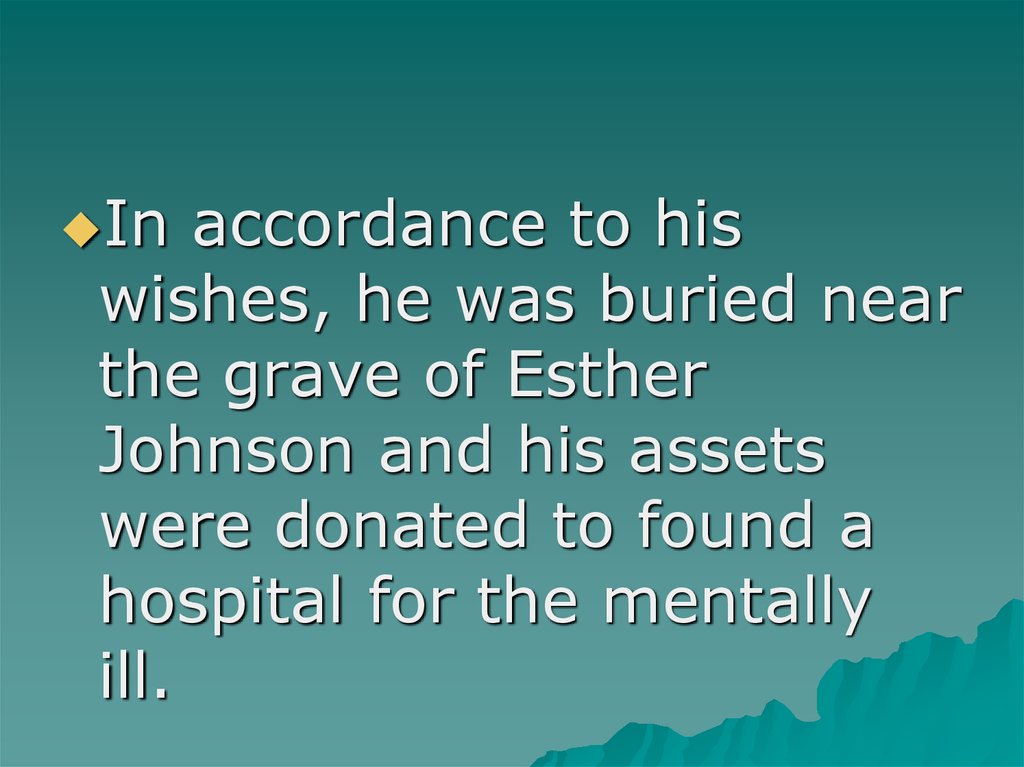Similar presentations:
Jonathan Swift
1. Jonathan Swift
2.
3.
Jonathan Swift was anAnglo-Irish poet, writer
and cleric who gained
reputation as a great
political writer and an
essayist. Jonathan, who
became Dean of St.
Patrick's in Dublin, is also
known for his excellence in
satire. His most
remembered works include
Gulliver's Travels, A
modest Proposal, An
Argument against
Abolishing Christianity and
A Tale of a Tub.
4. Childhood
Jonathan Swift wasborn on 30
November 1667 in
Dublin, Ireland to
an Irish father
Jonathan Swift and
an English mother
Abigail Erick.
5.
Jonathan, who wassecond child and the
only son of his
parents, was born
seven months after
his father's death. His
mother left him with
his father's family and
returned to England.
6.
Afterloosing his parent's contact,
Jonathan stayed with his uncle
Godwin, who sent him to Kilkenny
College for studies. After completing
primary schooling, Jonathan went on
to study at the Dublin University in
1682, and received a B.A.
7.
Degreein 1686. He had to drop his
further studies after a political clash
broke in Ireland. Jonathan was
forced to leave the place and moved
to England in 1688, where withy the
help of his mother, he secured a job
as secretary of an English diplomat
Sir William Temple at Moor Park.
8.
9.
Swift left Temple in1690 because of his
persisting illness but
returned in the next
year. It was during
this period, that he
began to show signs
of Meniere's disease,
which remained until
his death.
10.
Jonathan received his M.A.degree from the Oxford
University in 1692 and left
Moor Park and moved to
Ireland where he was
appointed as a priest in the
Church of Ireland. He
again returned to Temple
in 1696 forever. Working
as an assistant to Temple,
he was given many
responsibilities such as
writing memoirs and
correspondence for
publication.
11.
Swiftwrote The Battle of the Books
in 1690, a satire, which was finally
published in 1704. After Temple's
death on 27 January 1699, Swift
stayed in England for a brief period
and returned to Ireland to become
Dean of St. Patrick's Cathedral in
Dublin.
12.
13. Jonathan as a Writer
Swift was awardedDoctor of Divinity
from Trinity
College, Dublin in
1702. During this
period he wrote A
Tale of Tub and his
previous work A
Battle of Books
was published.
14.
Withthe success of these two, he
began to achieve excellence as a
writer and came into contact with
Alexander Pope, Johan Gay and John
Arbuthnot. During year 1707-1709,
Swift remained politically active and
again in 1710, he traveled to London
seeking the claims of Irish clergy to
the First-Fruits and Twentieths.
15.
As his urges to theWhig administration of
Lord Godolphin went
unheeded, he
published a political
pamphlet The Conduct
of the Allies in 1711.
The pamphlet harshly
criticized the Whig
government for its
incapability to end the
war with France.
16.
Tory government, an opposition party tothe Whig government, recruited Swift as
editor of The Examiner when it came in
power in 1710. The party initiated a
negotiation with France and signed the
Treaty of Utrecht in 1713 which ended the
War of the Spanish Succession. After the
Whig government again returned to power
in 1714, the Tory leaders were charged
with treason and tried for illegal
negotiation with France.
17.
18. Controversies over Personal Life
Swift was widelybelieved to share
an intimate and
close relationship
with a girl Esther
Johnson. He first
met her when she
was eight years
old.
19.
The two maintained aclose but ambiguous
relationship for the
rest of his life. They
were believed to have
secretly married,
though there is no
definite proof
corroborating this.
20.
Butit was certain that she held a
special place in his heart throughout
his life. In his later life, Swift was
linked to another fatherless girl,
Esther Vanhomrigh, who presumably
was infatuated with him, though
Swift later tried to break off
relationship with her.
21.
22. Later Life and Death
23.
With Whig governmentcoming to power, Jonathan
Swift left England for one
more time. He returned to
Ireland and began a series
of political writing in Irish
support. Some of his
notable works during this
period are Proposal for
Universal Use of Irish
Manufacturer (1720),
Drapier’s Letters (1724)
and A Modest Proposal
(1729).
24.
Some of hismasterpiece, Travels
into Several Remote
Nations of the World
and Gulliver’s Travels
also came during that
period. In 1726 he
visited England where
he stayed with his life
long friends Alexander
Pope, John Arbuthnot
and John Gay.
25.
With the help of them,Swift anonymously
published his book
Gulliver’s Travels in
1726. The book was
proved to be such a
huge success that it’s
French, German and
Dutch version had to
be published in 1727.
26.
Esther Johnson’sdeath on 28 January
1728 shattered him
and pushed him in to
a state of mental
illness. He wrote his
book The Death of
Mrs. Johnson as a
tribute to Esther
Johnson after her
death.
27.
Movedby her death, Swift began to
write extensively on death and in
1731, he wrote Verses on the Death
of Dr. Swift, which was published in
1739. Before that in 1738, he had
begun to show signs of mental illness
and gradually lost his ability to speak
and walk. On 19 October 1745
Jonathan Swift died.
28.
29.
Inaccordance to his
wishes, he was buried near
the grave of Esther
Johnson and his assets
were donated to found a
hospital for the mentally
ill.






























 biography
biography








